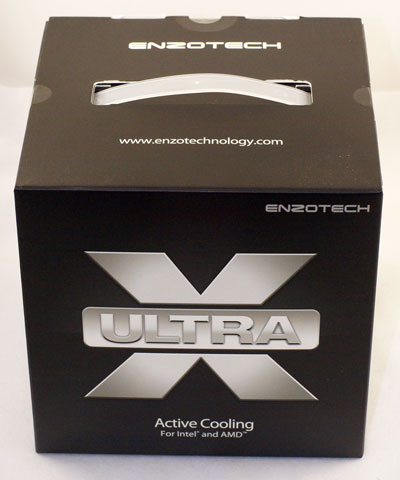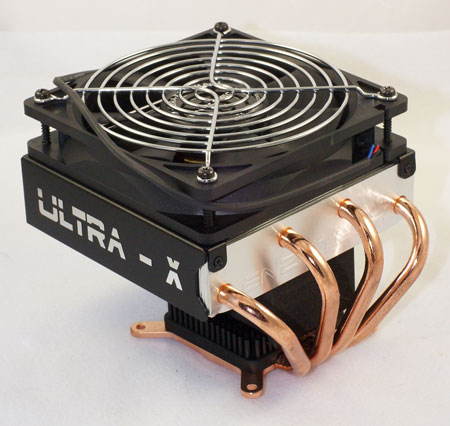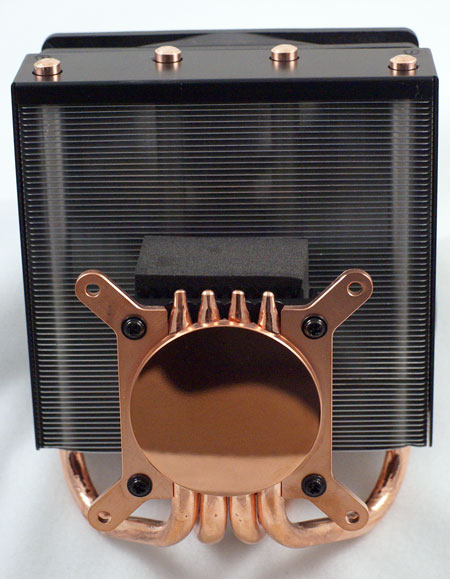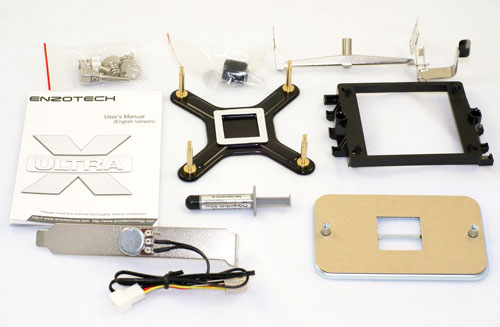Enzotech Ultra-X: If Looks Could Chill
by Wesley Fink on June 27, 2007 3:00 AM EST- Posted in
- Cases/Cooling/PSUs
Enzotech Ultra-X
The Ultra-X comes in a matte black and silver package with a side window that highlights the heatpipe cantilever.

All the information you need to make a buying decision is on the box - specifications, included accessories, CPU compatibility, etc. The only thing missing is a quick trip to AnandTech to check out how the cooler compares to others in cooling efficiency. Inside the package is a clear plastic molded clamshell that protects the individual components.

The cooler is designed around a high output down-facing fan blowing across a large cantilever of horizontal heatpipes cooled by vertical aluminum fins. The fin array is enclosed on all sides. Heatpipes extend from a base that is also cooled by another small heatsink to the heatpipe cantilever

Enzotech prominently features the mirror-finished copper base in all their literature. They claim the base is machined to 0.0003 per inch run out, "which optimizes surface contact and maximizes thermal conductivity performance". The mirror finish is certainly an excellent execution of machining. Our performance tests will better indicate whether it really makes any difference in performance.

The Ultra-X fan is a stock Delta fan controlled by a variable speed rheostat that can mount in an available card slot. This allows control of the fan speed even if the case is closed. Many of us remember Delta fans from AMD socket A days where the Delta delivered incredible air output at the price of extreme noise. This Delta claims output as high as 82.7 CFM at a less than quiet 38.5dbA. We will be measuring noise performance and reporting it compared to other tested coolers on p. 7.

Accessories include a mounting base and spring loaded screws for Intel socket 775 and a complete base, cage and clip for AMD sockets. Mounting of either Intel or AMD processors is very simple. Also included is a small syringe of premium Arctic Silver 5, and very clear installation instructions. Mounting is simple and very secure with either 775 or AMD. However, you will have to remove the motherboard to install the cooler - at least on Intel 775. While the motherboard is removed to place the base through the 4-holes in the 775 motherboard, go ahead and mount the spring screws. It can be really difficult to try to tighten these after the board is remounted.
Should you require further help with the installation process, Enzotech provides very clear installation videos for both Intel and AMD in the Ultra-X section of their website. While the Ultra-X is a very heavy cooler at 835g it is good to see strong and effective installation options available with the cooler. Ultra-X was very secure on both 775 and AMD sockets, providing peace of mind when mounting this heavy cooler on an expensive motherboard.
The Enzotech Ultra X is one of the more expensive coolers we have tested. Web prices ranged from $63 to $65. Enzotech distributes their products through specialty cooling shops, so you will not find them at volume resellers. Our sincere thanks go to Frozen CPU for arranging a retail review sample of the Ultra-X. We would not have been able to turn a review around so quickly without their help.
Specifications
Our test system is Intel socket 775, but the Ultra-X will also mount on any recent AMD socket as well - including 754/939/940 and AM2. The Enzotech kit includes the back plate, cage, and mounting clip for AMD processors. All the needed hardware is included, and installation is even easier than the 775 install - particularly on a mounted motherboard.
The Ultra-X is relatively large, but it is shorter in height than most of the heatpipe tower coolers. The heatpipe cantilever overhangs the base, so you can also cool a Northbridge or hot power transistors depending on how you mount the cooler. Enzotech did not provide recommended orientations for the cooler for various case designs.
The EVGA 680i is a difficult to fit board due to the copper-finned heatsink and fan cooling the Northbridge. The Enzotech fit comfortably but clearances required mounting the cooler out of the case before mounting the motherboard in the case. Installation was also an easy task on the ASUS Striker and ASUS Commando, and on the two new ASUS P35 boards - the P5K Deluxe and P5K3 Deluxe. The P5K3 Deluxe will likely become a fit test for any motherboard, since the heatpipes completely circle the CPU socket and connect various cooling heatsinks around the CPU socket.
The Ultra-X comes in a matte black and silver package with a side window that highlights the heatpipe cantilever.

All the information you need to make a buying decision is on the box - specifications, included accessories, CPU compatibility, etc. The only thing missing is a quick trip to AnandTech to check out how the cooler compares to others in cooling efficiency. Inside the package is a clear plastic molded clamshell that protects the individual components.

The cooler is designed around a high output down-facing fan blowing across a large cantilever of horizontal heatpipes cooled by vertical aluminum fins. The fin array is enclosed on all sides. Heatpipes extend from a base that is also cooled by another small heatsink to the heatpipe cantilever

Enzotech prominently features the mirror-finished copper base in all their literature. They claim the base is machined to 0.0003 per inch run out, "which optimizes surface contact and maximizes thermal conductivity performance". The mirror finish is certainly an excellent execution of machining. Our performance tests will better indicate whether it really makes any difference in performance.

The Ultra-X fan is a stock Delta fan controlled by a variable speed rheostat that can mount in an available card slot. This allows control of the fan speed even if the case is closed. Many of us remember Delta fans from AMD socket A days where the Delta delivered incredible air output at the price of extreme noise. This Delta claims output as high as 82.7 CFM at a less than quiet 38.5dbA. We will be measuring noise performance and reporting it compared to other tested coolers on p. 7.

Accessories include a mounting base and spring loaded screws for Intel socket 775 and a complete base, cage and clip for AMD sockets. Mounting of either Intel or AMD processors is very simple. Also included is a small syringe of premium Arctic Silver 5, and very clear installation instructions. Mounting is simple and very secure with either 775 or AMD. However, you will have to remove the motherboard to install the cooler - at least on Intel 775. While the motherboard is removed to place the base through the 4-holes in the 775 motherboard, go ahead and mount the spring screws. It can be really difficult to try to tighten these after the board is remounted.
Should you require further help with the installation process, Enzotech provides very clear installation videos for both Intel and AMD in the Ultra-X section of their website. While the Ultra-X is a very heavy cooler at 835g it is good to see strong and effective installation options available with the cooler. Ultra-X was very secure on both 775 and AMD sockets, providing peace of mind when mounting this heavy cooler on an expensive motherboard.
The Enzotech Ultra X is one of the more expensive coolers we have tested. Web prices ranged from $63 to $65. Enzotech distributes their products through specialty cooling shops, so you will not find them at volume resellers. Our sincere thanks go to Frozen CPU for arranging a retail review sample of the Ultra-X. We would not have been able to turn a review around so quickly without their help.
Specifications
Our test system is Intel socket 775, but the Ultra-X will also mount on any recent AMD socket as well - including 754/939/940 and AM2. The Enzotech kit includes the back plate, cage, and mounting clip for AMD processors. All the needed hardware is included, and installation is even easier than the 775 install - particularly on a mounted motherboard.
| Enzotech Ultra-X Specifications | ||||
| Heatsink | ||||
| Dimensions | 148(W) X 148(D) X 118(H)mm | |||
| Weight | 835g | |||
| Material | Mirror-Polished Copper Base and Aluminum Fins | |||
| Heatpipes | Four 8mm copper heatpipes | |||
| Fan | ||||
| Fan Size | 120 x120x 25mm | |||
| Bearing Type | 2-ball Delta AFB1212H-FOO | |||
| Connector | 3-pin with integral fan-speed rheostat | |||
| Speed | Lo Speed | 1,200rpm | Hi Speed | 2,500rpm |
| Noise Level | Lo Speed | 24.5dBA | Hi Speed | 38.5dBA |
| Fan Output | Lo Speed | 35.8cfm | Hi Speed | 82.67cfm |
The Ultra-X is relatively large, but it is shorter in height than most of the heatpipe tower coolers. The heatpipe cantilever overhangs the base, so you can also cool a Northbridge or hot power transistors depending on how you mount the cooler. Enzotech did not provide recommended orientations for the cooler for various case designs.
The EVGA 680i is a difficult to fit board due to the copper-finned heatsink and fan cooling the Northbridge. The Enzotech fit comfortably but clearances required mounting the cooler out of the case before mounting the motherboard in the case. Installation was also an easy task on the ASUS Striker and ASUS Commando, and on the two new ASUS P35 boards - the P5K Deluxe and P5K3 Deluxe. The P5K3 Deluxe will likely become a fit test for any motherboard, since the heatpipes completely circle the CPU socket and connect various cooling heatsinks around the CPU socket.










33 Comments
View All Comments
GlassHouse69 - Friday, June 29, 2007 - link
This screams for a simple fan swap. Either a Nexus fan, a Yate loon, or a Papst 120. That with a front fan controller would make this a very decent cooler without the noise.mpelle4456 - Thursday, June 28, 2007 - link
I think it’s great that Anandtech is doing reviews on heat sinks, but I can’t get behind some of your methodology – i.e., the “highest stable overclocking” tests for heat sinks.There are so many, many variables at play when overclocking a computer, that unless every test was done with exactly the same components – the exact same CPU, the exact same motherboard, the exact same RAM, and so on – all the exact same hardware, with the exact same BIOS settings and software – then the test is not in any way valid.
Tests using the same model/brand CPU’s or RAM just don’t it – there are way too many variations between different CPU’s and steppings. An Opteron 170 CCB1E 0550VPMW might perform totally different to an Operton 170 CCBWE 0609FPAW. The same is true with RAM and other similar components.
The rest of the tests are more valuable – assuming that each of the 20 or so heat sinks were tested with the same model processors.
The best, most useful methodology I have seen was used by Joe Citarella over at Overclockers.com -- http://www.overclockers.com/articles373/p4sum.asp">http://www.overclockers.com/articles373/p4sum.asp
In their tests, they used a die simulator which put out a specific, precise amount of heat.
Their results are expressed as xx C/W (x degrees centigrade cooling per CPU watt – e.g., “To calculate what to expect for other CPUs, for every watt the CPU radiates, the heatsink will cool the core by the (C/W x watts) plus ambient temp. For example, at a fan inlet temp of 25 C, a C/W of 0.25 with a CPU radiating 50 watts means that the CPU temp will be 50 x 0.25 = 12.5 C over ambient temp, or 37.5 C.”
Unfortunately, it appears they discontinued their air cooling reviews some time ago.
Wesley Fink - Friday, June 29, 2007 - link
You are correct in stating highest overclock tests need all variables to remain the same. We DO use the excat same CPU, motherboard, RAM, BIOS settings. Hard Drive, and Software/OS image for all cooler overclocking tests.That is why we will retest a few representative coolers and start a new database when we make to the change to a new test bed. Ot os also why we are slow to change our test beds once they are established.
BigMacKing - Friday, June 29, 2007 - link
even in the same case?If it is, most of your cooler reviews will be worthless, unless users use the same case as you.
punko - Friday, June 29, 2007 - link
I'm not the sharpest stick in the umbrella stand, but I assume the case is standing normally, so the MB is vertical and the cooler is standing "sideways".With the down coolers, the heat pipes may disturbe the exhaust airflow. There are two possible arrangements at 90 degrees to each other. Would this affect things?
Note, also would apply to towers, which way do you point the fan? toward the exhaust vent?
For this cooler, there are 4 possible configurations, as the heatpipes are only on one side.
Is there any reason to suspect that the orientation of the cooler would have any difference?
Making sure the heated air is exhausted from the case is key, as is making sure you have a clear passage of cool air. any chance of recirculating the warm air will reduce cooling. the Towers have the advantage as the exhaust air would be moving the air not at the MB but directly at the exaust vent.
Just a thought
Tuffrabbit - Thursday, June 28, 2007 - link
Looks like the Thermalright Ultra 120 Extreme is going to be the winner for quite some time... But please keep bringing on all contenders ! Another great bout !magreen1 - Thursday, June 28, 2007 - link
I laughed out loudjebo - Thursday, June 28, 2007 - link
I wonder if the extra "bend" in heatpipes inherent in top-down coolers is preventing them from keeping up with the side-blowing coolers?Either way, each review solidifies my plan to pick up an Ultra 120 extreme once I make my quad-core upgrade :)
strikeback03 - Friday, June 29, 2007 - link
I'm wondering if it might be the extra length of the heatpipes before they get to the cooling fins. More heat would build up in the processor if it can't be moved away as efficiently.joetron2030 - Thursday, June 28, 2007 - link
First, I've really been enjoying these cooler tests. Very informative and I've been keeping track for my next build.One thing I would like to see, that I haven't seen so far, is a chart/graph that lists all of the tested coolers by weight. Considering one of the things mentioned in these tests is the weights of some of these coolers, it would be nice to be able to add that in as another point of comparison between these coolers. Unless, of course, their weights are all relatively close to one another.
Thanks for the consideration!